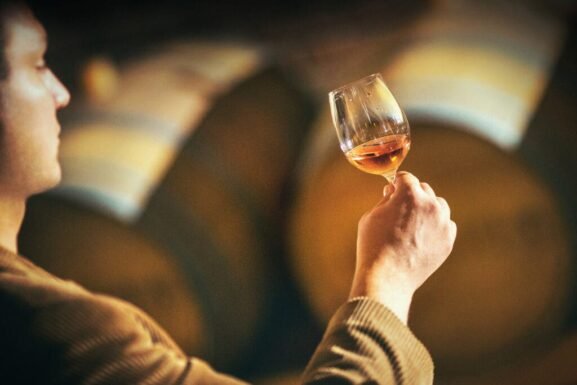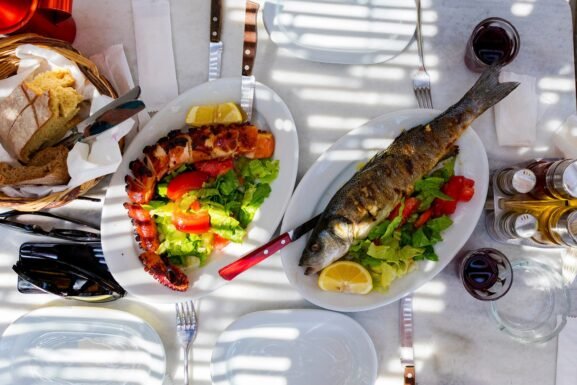What, Exactly, Is a Dry White Wine?
On paper, the definition of a ‘dry wine’ is simple: a wine that offers no residual sugar or perceptible sweetness. But for many members of the wine industry, dryness in white wine is a complicated topic. “The question—sweet versus dry—is a bit humorous to me,” says Jeremy Carter, winemaker of Tarpon Cellars. “In winemaking, dryness is simply how much sugar is left at the end of fermentation. But there’s a disconnect with consumers: many equate the term to more of a drying sensation, whether that stems from acid or tannins.”
While a wine may be completely dry by definition, it may not feel dry. Like Carter mentioned, many drinkers equate ‘dryness’ to sensory characteristics, like oak presence or the absence of ripe fruit notes. Other flavors in a dry wine may mimic sweetness: ripe, juicy fruit, bright acids and subtle tannins.
So, how do you understand dryness in white wine? Below, we got sommeliers and winemakers to help you unpack the often-misused term.
What Does Sweetness Mean?
“Without getting too into chemistry, fermentation is when a bacteria (yeast) eats sugar and produces alcohol,” explains Colin Hofer, general manager of Adorn Bar & Restaurant. “When all the sugar is gone, the bacteria has nothing else to eat and it dies, leaving a dry wine with an absence of sugar.”
This is why many pros, like Jean-Benoît Issele, the chef-sommelier of Apéritif at Viceroy Bali, define dryness in wine by the length of fermentation. “The longer the process, the less natural sugars remain in the grapes,” he explains. “In a finished wine, this means the wine presents a dry taste. With sweeter wines, the fermentation process is shorter, resulting in more residual sugar in the grapes.”
In the shop
Wine Enthusiast Somm Universal Handblown Wine Glass
In Stock | $34.99
Riesling
Bryce Faucheaux, wine director of Justine in New Orleans, finds Riesling is an excellent example of how to understand sweetness. Depending on style, “Riesling can be a sweet, botrytis-affected dessert wine from the Mosel in Germany, or it can be dry and mineral-driven from Alsace in France.”
If you search for a dry (or trocken) Riesling, you’ll be rewarded with a wildly food-friendly wine. “Riesling is my favorite grape, so I seek out a lot of bone-dry German Rieslings,” says Carter. “Those will be naturally high in acid and that combination makes for a perfect food wine in almost any situation.”
Wine Enthusiast recommends:
Gewurztraminer
Gewurztraminer is a shape-shifting grape. It can be used for hyper-sweet iterations with blossoming notes of sweet peach and lychee, or bone-dry wines with robust body, rich floral notes, a highly aromatic nose and low acidity (qualities which can trick drinkers into assuming the wine is sweet). Most frequently, Gewurztraminer is off-dry with a touch of sweetness.
Wine Enthusiast recommends:
Champagne
Champagne is one of the easiest categories to navigate in terms of dryness: most bottles are labeled to indicate sugar levels. The driest are “brut nature,” “brut sauvage” and “zero-dosage,” all of which are bone-dry with no added sugar (“dosage “refers to adding sugar). “Extra brut” is one step down on the dryness scale with no sugar added during dosage; however, unlike the previously mentioned bone-dry Champagnes, can contain up to six grams of sugar. This is followed by “brut,” the most common style of Champagne on the market, which boasts just a hint of sweetness. “Doux” (very sweet) sits on the opposite side of the sugar spectrum.
Danya Degen, general manager of Meli in Washington D.C., advises drinkers to consider how they enjoy tartness when buying extra brut Champagne. “If you don’t love biting into a lemon or green apple, you won’t like a brut zero Champagne,” says Degen. “You might appreciate a little bit more fruit and sugar, like you’d find in a Brut.”
Wine Enthusiast recommends:
Sauvignon Blanc
Sauvignon Blanc often feels incredibly dry and there are a few reasons why: standard Sauvignon Blanc is medium-bodied, giving a bit of weight and body to the wine. This is always balanced out by acidity—mouth-puckering and grapefruit-driven when the wine hails from warmer climates like New Zealand, and flinty and savory when made in cooler locales like Sancerre in France’s Loire Valley. While most Sauvignon Blanc is made as a dry, still wine, sweet versions are common, including many Sauternes, the noted Bordelaise dessert wine that is often blended with Sauvignon Blanc.
Wine Enthusiast recommends:
Malvasia
Malvasia, one of Italy’s most important white grapes, can be found in both dry and sweet styles such as Vin Santo or Madeira. When finished in a dry style, Malvasia is wonderfully aromatic and lifted. “I find Malvasia tends to have aromas ranging from tangerine, jasmine, apricot and quince, to tamarind and Earl Gray tea,” says Bruce Devlin, who works with Malvasia at Ballentine Vineyards in Napa Valley. “Malvasia tends to have a low pH and good acidity. It’s crispier than your typical Napa Valley white wines!” He appreciates Malvasia’s ability to cut through the spice and richness in Thai food and the char of grilled octopus.
Wine Enthusiast recommends:
Chardonnay
While almost all Chardonnay is made in a dry style, the grape’s prevailing characteristics can vary from vintner to vintner. Some are bone-dry and rich, while some Chardonnay showcases fruity notes, such as apple or lemon zest. When Chardonnay is aged in oak, those fruit characteristics turn into notes of vanilla or toast.
Wine Enthusiast recommends:
What Does it Mean When a Recipe Calls for a ‘Dry White Wine’?
The same rules for pairing wine with a meal factor into using it in recipes. “The nice thing about dry white wines is that they are so flexible in terms of food,” says Carter. “You can pair them with fatty foods because the acid and tannin will stand up to meat or cut into the richness of a cheese or dessert. You can pair them with lighter foods—they won’t overwhelm delicate flavors like oysters or roasted vegetables.”
If you’d prefer to incorporate white wine into the dish instead of alongside it, dry wine is equally versatile. Use dry wine for deglazing and making pan sauces, braising larger portions of meat or reducing liquids.
The biggest factor to consider: cooking wine concentrates its flavor. Sweet white wines will get sweeter and wines with driving acidity will only get more tart. (The same guidelines go for reds: avoid overly oaked bottles or intensely jammy or floral characteristics, which will only get more concentrated and bitter as they cook.)
When choosing a dry wine for cooking, a good rule of thumb is if it’s good enough to drink, it’s suitable for your food. But compared to your drinking wines, you don’t have to be as discerning with cooking wines—something under $20 will certainly do.
Published: April 12, 2024

